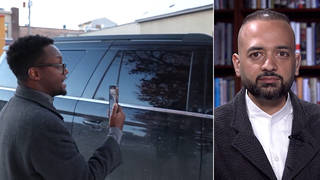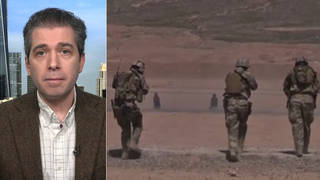
Topics
Guests
- Steve Downsexecutive director of the National Coalition to Protect Civil Freedoms and also works with Project SALAM, which published a report last year called “Inventing Terrorists: The Lawfare of Preemptive Prosecution.” He is also representing imprisoned Pakistani scientist Dr. Aafia Siddiqui.
In part two of our interview with Steve Downs, executive director of the National Coalition to Protect Civil Freedoms, he details his work on one of the most baffling cases in the so-called war on terror, the story of Aafia Siddiqui. In Pakistan, she is considered a political prisoner, but in the United States she is known as “Lady al Qaeda.” She is currently incarcerated at a federal prison in Fort Worth, Texas, where she is serving 86 years behind bars. Her lawyers say she hasn’t spoken with anyone for over a year. In 2010, the American-educated Pakistani neuroscientist was convicted of attempted murder for shooting at U.S. soldiers and FBI agents while being questioned in Afghanistan in 2008. Prior to this incident, Siddiqui said she was held and tortured in secret U.S. prisons over a five-year period. Her U.S-based lawyers recently visited Pakistan where they met with her sister, Dr. Fowzia (Siddiqui), and discussed efforts to repatriate her. Downs also works with Project SALAM, which published a report last year called “Inventing Terrorists: The Lawfare of Preemptive Prosecution.”
Watch Part 1 of our interview with Downs, in which he also discusses the new film “(T)ERROR.”
Transcript
AMY GOODMAN: This is Democracy Now!, democracynow.org, The War and Peace Report. I’m Amy Goodman, as we turn today to one of the most baffling cases in the so-called war on terror, the story of Aafia Siddiqui. In Pakistan, she’s considered a political prisoner, but in the United States she’s known as “Lady al Qaeda.” She’s currently incarcerated at a federal prison in Fort Worth, Texas, where she’s serving 86 years behind bars. Her lawyers say she hasn’t spoken with anyone for over a year.
In 2010, the American-educated Pakistani neuroscientist was convicted of attempted murder for shooting at U.S. soldiers and FBI agents while being questioned in Afghanistan in 2008. Prior to this incident, Siddiqui said she was held and tortured in secret U.S. prisons over a five-year period. Her U.S.-based lawyers recently visited Pakistan, where they met with her sister, Dr. Fowzia [Siddiqui], and discussed efforts to repatriate her. This is attorney Kathy Manley.
KATHY MANLEY: One of the first things that needs to happen is for the government of Pakistan to officially request Aafia back, to officially request her repatriation. And then we can start to work on the U.S. end, and hopefully something can happen. We know that she’s having a very difficult time in the prison in Texas. We were trying to get an independent medical exam for her, you know, and it’s really hard to even communicate with her. So, you know, it’s a very difficult situation.
AMY GOODMAN: Many human rights groups have long argued Siddiqui was forcibly disappeared by Pakistani authorities in 2003, and interrogated and tortured at the behest of the United States.
Well, for more, we’re joined by one of Siddiqui’s lawyers, Steve Downs, who just returned from Pakistan, executive director of the National Coalition to Protect Civil Freedoms and also works with Project SALAM, which published a report last year called “Inventing Terrorists: The Lawfare of Preemptive Prosecution.”
So, first, Steve Downs, if you can tell us what the government’s case is against her, why she was convicted of attempted murder?
STEPHEN DOWNS: Right. And I want to make it very clear from the start: She was never charged or convicted of terrorism. Even though there are allegations that have been floated by the U.S. government for years that she was somehow connected with al-Qaeda, in fact no evidence has ever been shown, and most of those allegations have been shot down and prove that the—prove to be untrue.
What happened was that she and her three children disappeared off the streets of Pakistan, off the streets of Karachi, in 2003. And for five years, nobody would admit that they knew where she was. In 2008, Barack Obama had just come in as president and wanted to close the—ordered the black sites be closed. And at about the same time, Yvonne Ridley published a book, which identified Aafia as being Prisoner 650 associated with Bagram. Soon after that, within a few weeks of that, of her book coming out, Aafia is discovered wandering around dazed in Ghazni province. And we know that at that point a tip had been made to the police in Ghazni that a terrorist would be coming through, and she was very dangerous and should be shot on sight. Fortunately for Aafia, when she got off the bus, she heard a call to prayer and turned toward the mosque and went into the mosque, where she fainted and was taken care of by the people there, and so she was arrested by the Afghani police and not shot.
The Americans heard about this and said they wanted to talk to her. The Afghani police said, “Fine. Come down to the police station. She’ll be there tomorrow.” So, the Americans went down, went into the police station. There were six armed military people. And Aafia came out from behind a curtain in the police station, and she was promptly shot by the Americans, twice, in the stomach. She was then loaded onto a plane and taken to the United States, without any apparent legal authority, and charged with the attempted murder of the very soldiers that had shot her.
At the trial, some of the soldiers claimed that she had grabbed one of the rifles that had been put down by the soldiers while they were waiting, and had gotten off two shots, had shot at them. And the prosecution put in a picture of the wall showing two holes in the wall, which they said was where she missed. The defense then put in a picture of the same wall, with the same two holes, showing that it had been taken weeks earlier, and said there were no bullet holes in those—no bullets in the two holes, so, obviously, that they could not have been the missed shots. Only two shell casings were recovered, which corresponded with a pistol with which she was shot. And there was no—her fingerprints were not on any of the guns. So no forensic evidence supported any of the kind of confused testimony of the soldiers.
But she was convicted and sentenced to 86 years in jail. So, the only charge against her was the attempted murder of these soldiers under very bizarre conditions which seem highly unlikely and for which there is virtually no evidence.
AMY GOODMAN: And so, explain where she was brought, where she was tried, and how she ended up with 86 years in prison.
STEPHEN DOWNS: She was tried in Manhattan in a trial—and the trial was famous in that it—the judge ruled at the very beginning that the five years during which she and her children had disappeared was irrelevant to the case, and there’s no evidence could be presented about that. Now, it happened, when she arrived in Ghazni, she came with a boy who was carrying a bag of documents. And those documents contained all sorts of terrorist literature and information, even some chemicals that might be used. And so, at the trial, the prosecutor, after she was convicted, offered those bags to show that she was involved somehow in terrorism, and so she got a terrorism enhancement. A terrorism enhancement essentially quadruples the length of any normal sentence. And so, that, along with other enhancements that were added, boosted her time that she should serve up to 86 years. Most people looking at that sentence would say that’s absurd. Here she was charged for a crime in which nobody was hurt, nobody was even injured. And yet—and she was the one that was shot. And yet, she is given 86 years. But that’s how that happened.
AMY GOODMAN: So, she is now imprisoned in Texas.
STEPHEN DOWNS: Yes.
AMY GOODMAN: Is this the same prison where the attorney Lynne Stewart was held?
STEPHEN DOWNS: Yes, and it is essentially in a medical facility. Aafia has now been about 12 years, a little over 12 years, in essentially solitary confinement, tortured part of the time. And we know that this kind of prolonged solitary confinement and torture can do a lot of things to the human mind. It’s very common, typical, that people start to break down.
AMY GOODMAN: When you say “tortured,” what do you mean?
STEPHEN DOWNS: Well, her face, when she came out—they actually did a news conference after she was picked up in Ghazni province and before she was shot, and it’s a very iconic picture, because it shows the face of someone who has been completely tortured and abused. The nose looks like it’s broken. The teeth look like they’ve been knocked out. I mean, and she was a very pretty, lively woman before. And here she just looks like somebody that has been beaten and abused.
AMY GOODMAN: Now, can you explain—she got 86 years, but how is it that no one’s been able to contact her for the last year?
STEPHEN DOWNS: Well, this is one of the ironies of the case. During the trial, questions were raised as to her mental capability. And at the end, Judge Berman, who applied the sentence, said that there seemed to be at least—he had found her competent to stand trial, but he said there did seem to be some issues concerning her mental ability at this point, after all this abuse. And so, he sent her to Carswell, where—which is a medical hospital, to be treated. But for some reasons that we don’t really understand, she has been in solitary confinement in Carswell, which, of course, is the very conditions that caused the problem in the first place. Because she’s being held in solitary confinement, it’s very hard for anyone to come in and make contact with her. And she, herself, is not comfortable using telephones and things like that. And the result is that her family has had no contact with her for over a year. At one point, they asked for consular visits from the Pakistani Embassy, and they sent two consular officers on two different occasions. But in both cases, she sat with her back to the officers and would not talk to them or show her face. So, there was concern as to whether or not they were even seeing Aafia. And I think part of the whole problem here is that the whole world who knows Aafia is very concerned as to whether or not the American government, who obviously over the years has made life very difficult for Aafia, whether or not they are covering up a very serious situation. Maybe she’s dead. Maybe she’s in very bad health, and she’s not properly being treated.
AMY GOODMAN: So, you—in this last 10 seconds, you are calling for today?
STEPHEN DOWNS: I’m calling for an independent medical examination. We’d like to have Dr. Fowzia Siddiqui, who is her sister, to be on that team and to be allowed to come in. And I’d like the Pakistani government to request that of the American government.
AMY GOODMAN: Well, Stephen Downs, I want to thank you for being with us, executive director of the National Coalition to Protect Civil Freedoms, also works with Project SALAM, which published a report last year called “Inventing Terrorists: The Lawfare of Preemptive Prosecution,” also representing imprisoned Pakistani scientist, Dr. Aafia Siddiqui, who is in prison for 86 years in Texas. This is Democracy Now! I’m Amy Goodman. Thanks for joining us.












Media Options